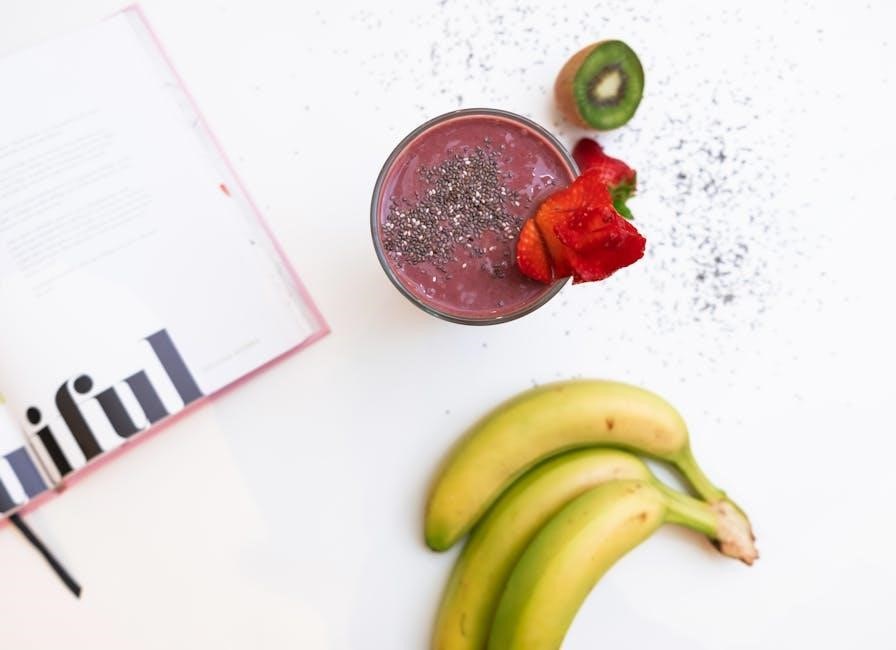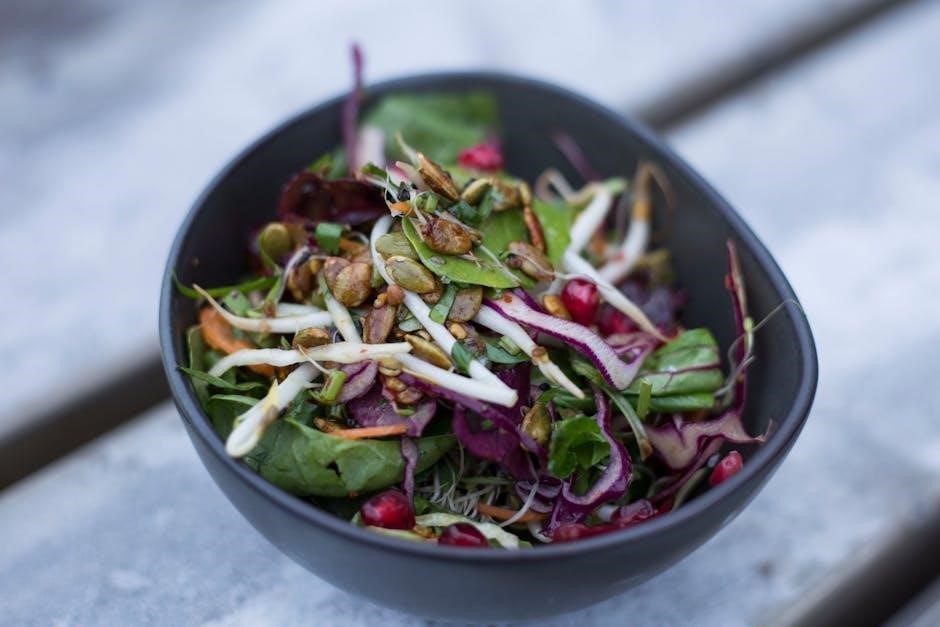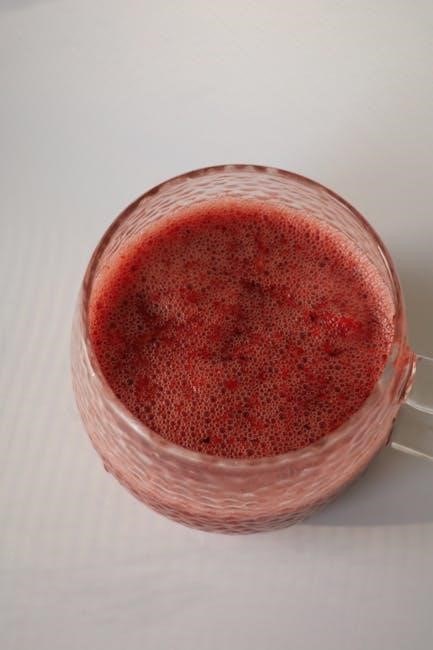
printable 21 day sugar detox meal plan pdf
A structured 21-day sugar detox meal plan helps reset eating habits, reducing sugar cravings and improving overall nutrition. It provides a clear, day-by-day guide to healthy meals.
1.1 What is a 21 Day Sugar Detox?
A 21-day sugar detox is a structured program designed to help individuals reduce or eliminate added sugars from their diet. It focuses on resetting eating habits, cutting cravings, and promoting healthier food choices. The detox typically lasts three weeks, allowing the body to adapt to new nutritional patterns. By eliminating sugary foods and drinks, participants aim to improve energy levels, digestion, and overall well-being. It’s a gradual process that encourages mindful eating and the inclusion of nutrient-dense meals.
1.2 Benefits of a Sugar Detox
Embarking on a sugar detox offers numerous health benefits, including reduced cravings, improved energy levels, and enhanced digestion. It helps stabilize blood sugar levels, promoting weight loss and better overall well-being. By focusing on nutrient-rich foods, participants often experience clearer skin and improved mental clarity. The detox also fosters healthier eating habits, setting the foundation for long-term dietary changes. Many report feeling more energetic and motivated, making it easier to maintain a balanced lifestyle beyond the detox period.
1.3 Importance of a Structured Meal Plan
A structured meal plan is crucial for the success of a sugar detox. It provides clear guidance, ensuring participants stay on track without feeling overwhelmed. By outlining daily meals, it eliminates decision fatigue, making healthy choices easier. A well-designed plan also balances nutrition, ensuring adequate intake of proteins, fats, and fiber. This structure helps prevent cravings and keeps energy levels steady. Additionally, it saves time, as meals are pre-planned, reducing the likelihood of resorting to high-sugar convenience foods. Consistency is key to achieving detox goals and maintaining progress.

Understanding the Basics of Sugar Detox

A sugar detox resets your diet by eliminating added sugars, focusing on whole foods to reduce cravings and improve energy levels naturally over 21 days.
2.1 Foods to Avoid During the Detox
During a sugar detox, it’s crucial to eliminate sugary drinks, refined carbohydrates, processed snacks, and foods with added sugars. Avoid sugary beverages like sodas and sweetened teas, as well as baked goods, candies, and processed foods containing high-fructose corn syrup. Natural sugars, like those in excessive fruit consumption or dairy products, should also be limited. Hidden sugars in condiments, dressings, and packaged foods must be identified and avoided to ensure the detox’s effectiveness in resetting your taste buds and reducing sugar cravings.
2.2 Foods to Include in Your Diet
Focus on whole, nutrient-dense foods during the detox, such as vegetables, lean proteins, healthy fats, and whole grains. Incorporate leafy greens, colorful vegetables, and low-sugar fruits like berries. Opt for grass-fed meats, wild-caught fish, and free-range eggs. Nuts, seeds, and avocados provide healthy fats. Whole grains like quinoa and brown rice are excellent choices. Stay hydrated with water, herbal teas, and electrolyte-rich beverages to support detoxification and reduce sugar cravings; These foods help stabilize blood sugar and promote overall well-being during the detox period.
2.3 How to Prepare for the Detox
Start by clearing your pantry of sugary and processed foods to avoid temptation. Stock up on fresh vegetables, lean proteins, and healthy fats. Plan your meals in advance using a printable 21-day sugar detox meal plan PDF. Stay hydrated by drinking plenty of water and consider meal prepping to save time. Mindset preparation is equally important—commit to the process and set realistic expectations. This foundational work will help you stay focused and motivated throughout the detox journey.

Sample Meal Plan for the 21 Day Sugar Detox
This structured plan provides a comprehensive guide for three phases: Days 1-7, 8-14, and 15-21. Each phase offers balanced meals, snacks, and recipes to gradually reduce sugar intake, ensuring nourishment and variety. The plan emphasizes whole foods, lean proteins, and healthy fats, while avoiding sugary and processed items. Printable PDF versions allow easy tracking and preparation, helping users stay organized and committed to their detox journey.

3.1 Day 1-7 Meal Plan
Days 1-7 focus on eliminating sugar cravings with nutrient-rich meals. Breakfast options include scrambled eggs with spinach or avocado toast. Lunches feature grilled chicken salads or vegetable stir-fries; Dinners emphasize lean proteins like salmon or turkey, paired with roasted vegetables. Snacks like almonds or celery with almond butter are recommended. The plan avoids sugary and processed foods, emphasizing whole, natural ingredients. Printable PDF versions provide clear portion sizes and meal timing, ensuring a smooth transition into the detox. Staying hydrated is encouraged to support detoxification and reduce cravings.

3.2 Day 8-14 Meal Plan
Days 8-14 introduce more variety while maintaining sugar-free habits. Breakfasts include omelets with veggies or chia pudding. Lunches feature grilled chicken or turkey lettuce wraps with avocado. Dinners focus on baked fish, beef, or vegetable stir-fries. Snacks like hard-boiled eggs or cucumber slices are suggested. The plan emphasizes whole foods, avoiding processed items. Printable PDF guides provide detailed meal ideas, ensuring continued progress. Staying consistent with meal timing and hydration supports sustained energy and reduced cravings, helping the body adapt to the new diet.
3.3 Day 15-21 Meal Plan
Days 15-21 focus on refining habits and introducing new recipes. Breakfast options include scrambled eggs with spinach and tomatoes or Greek yogurt with berries. Lunches feature grilled chicken salads, zucchini noodles, or stuffed bell peppers. Dinners emphasize lean proteins like salmon, steak, or pork, paired with roasted vegetables. Snacks such as celery sticks with almond butter or a handful of nuts are suggested. The printable PDF guide ensures meals are balanced, flavorful, and sugar-free, helping you finish the detox strong and confident.

Tips for Sticking to the Meal Plan
Sticking to the meal plan requires commitment and preparation. Plan meals, shop for ingredients, and avoid hidden sugars. Stay hydrated and focus on nutrient-dense foods to succeed.
4.1 Meal Preparing and Planning
Meal preparing and planning are crucial for sticking to the 21-day sugar detox. Start by organizing your meals for the week, ensuring each meal aligns with the detox guidelines. Use the printable PDF plan to map out breakfast, lunch, dinner, and snacks in advance. Shop for fresh, whole ingredients like vegetables, lean proteins, and healthy fats. Chop vegetables and prepare ingredients ahead of time to save time during the week. This approach helps maintain consistency and reduces the likelihood of making unhealthy choices.
4.2 Avoiding Hidden Sugars
Avoiding hidden sugars is essential for a successful 21-day sugar detox. Many processed foods, condiments, and even seemingly healthy options contain added sugars. Always read labels to identify unexpected sources of sugar. Choose whole, unprocessed foods like vegetables, meats, and nuts, which naturally contain minimal sugar. Replace sugary condiments with alternatives like fresh herbs or vinegar. By being mindful of hidden sugars, you can stay on track with your detox goals and reduce overall sugar intake effectively.
4.3 Staying Hydrated
Staying hydrated is crucial during a sugar detox to flush out toxins and reduce cravings. Drink plenty of water throughout the day, aiming for at least eight glasses. Start your morning with a glass of water and consider adding a slice of lemon for a refreshing boost. Herbal teas and infused water can also keep hydration interesting. Avoid sugary drinks and opt for natural beverages like coconut water or unsweetened almond milk. Proper hydration supports digestion and helps your body function optimally during the detox process.
Common Challenges and Solutions
Cravings, social pressures, and plateaus are common challenges. Stay prepared with healthy snacks, communicate your goals, and seek support to overcome these obstacles effectively.
5.1 Dealing with Sugar Cravings
Sugar cravings are a common challenge during detox. Stay hydrated, as thirst is often mistaken for hunger. Opt for healthy snacks like nuts or veggies with dips. Incorporate protein-rich meals to stabilize blood sugar levels. Physical activity, such as a short walk, can distract and reduce cravings. Plan ahead by stocking sugar-free alternatives and seeking support from family or online communities. Remember, cravings are temporary, and persistence leads to long-term success in your detox journey.

5.2 Managing Social Eating Situations
Social gatherings can be tricky during a sugar detox. Prepare by eating a protein-rich meal beforehand to reduce temptation. Choose grilled meats, salads, or vegetable dishes. Bring a sugar-free option to share, ensuring you have a healthy choice. Politely decline sugary offerings and explain your dietary commitment without feeling awkward. Focus on conversation and connection rather than food. Remember, staying consistent with your detox goals is worth the temporary discomfort. Plan ahead and stay confident in your choices to navigate social eating successfully.
5.3 Overcoming Plateaus
Plateaus during a sugar detox can occur due to metabolic adjustments or lack of variety in meals. Shake things up by introducing new recipes or increasing physical activity. Ensure hydration and adequate sleep, as these play a role in metabolism. Reassess portion sizes and macronutrient balance to reignite progress. Track your intake and adjust as needed. Celebrate small victories, like reduced cravings, to stay motivated. Remember, progress may not always be linear, but consistency will ultimately lead to success. Stay committed and patient with your body’s journey.
Completing the 21-day sugar detox is a significant milestone. You’ve reset your habits, reduced cravings, and improved your health. Continue embracing a low-sugar lifestyle and track your progress for lasting success.
6.1 Maintaining a Low-Sugar Diet After the Detox

Maintaining a low-sugar diet after the detox requires commitment and mindful eating. Focus on whole, nutrient-dense foods like vegetables, lean proteins, and healthy fats. Avoid processed foods and hidden sugars by reading labels diligently. Plan meals in advance to prevent temptation and incorporate new recipes to keep your diet exciting. Staying hydrated and listening to your body’s needs will help sustain your progress. Engage with a supportive community or coach to stay motivated and celebrate small victories along the way.
6.2 Tracking Progress and Celebrating Success
Tracking your progress during and after the detox is crucial for motivation. Use a journal to document meals, cravings, and physical changes. Take progress photos and measurements to visualize improvements. Celebrate non-scale victories, like increased energy or clearer skin. Reward yourself with non-food treats, such as a new outfit or a relaxing bath. Sharing achievements with a support group can enhance accountability and joy. Remember, every small step is a success, and acknowledging progress strengthens commitment to a healthier lifestyle.
6.3 Resources for Further Support
For continued success, utilize resources like printable guides, sugar-free cookbooks, and online forums. Mobile apps can track progress and offer meal ideas. Join social media groups for motivation and recipes. Blogs and YouTube channels dedicated to sugar detox provide inspiration and tips. Consider consulting a nutritionist for personalized advice. Remember, community support and educational tools are key to maintaining your low-sugar lifestyle beyond the detox program. These resources will help you stay informed, motivated, and equipped for long-term health.